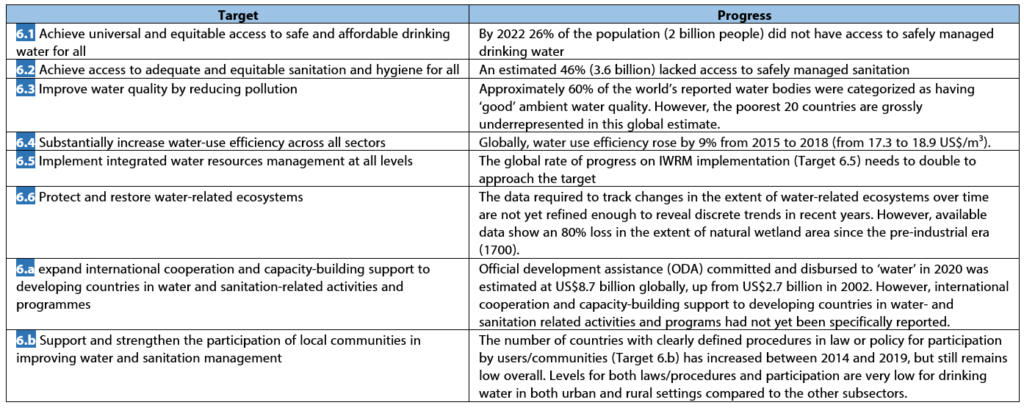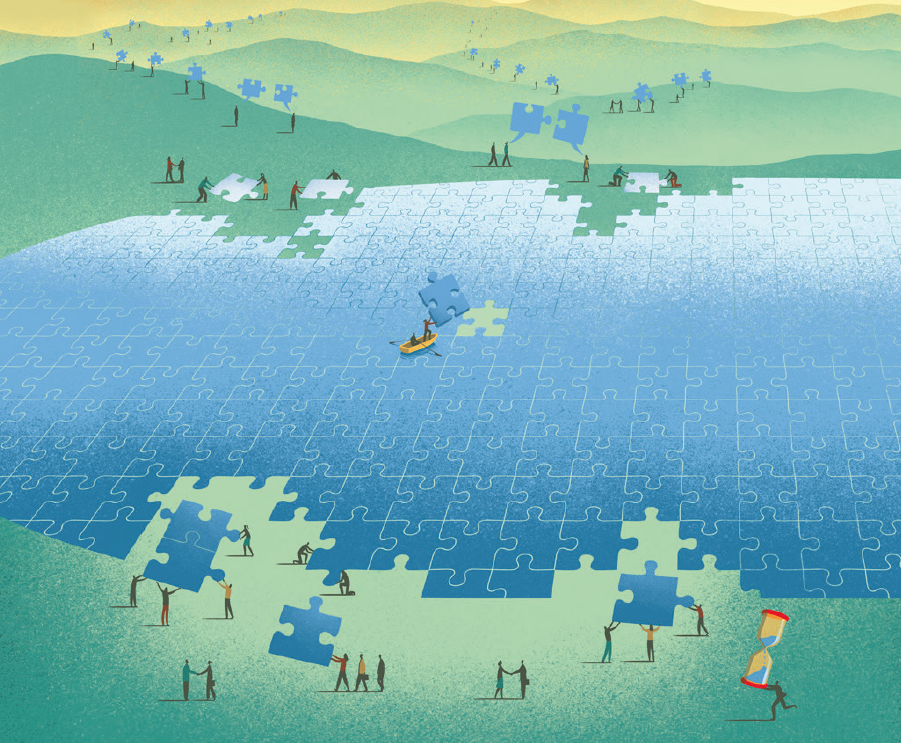Even as I write, the UN’s first water conference in an entire generation is into its first formal session after a day of side events at the UNHQ, NYC, USA. That the water issue is top of the heap of world threatening crises is a given. On one side it is a crisis in itself, on another side it is an aggregator of crises and on a third side it is a multiplier of other crises. It is no small wonder therefore that the UN is sitting up and taking notice.
The talks were preceded by the World Water Development Report compiled by UNESCO which looks actually good for a change because it checks many of the boxes that need to be checked on how to deal with this issue. One key factor it points out is that with respect to Goal 6 (Water and Sanitation for all) we are lagging far behind in achieving the targets. We are so far off-track on some of those that we will need to increase our effort fourfold or more to make good on our own promises to ourselves. Worst still, it points out that with respect to 5 of the 11 target indicators, we have absolutely no clue where we stand simply because we have no quantified information on global progress on them.
Take a look at the progress on goal 6 targets and I am sure you will do what I did and go “sheeeeeesh”!

Source: The United Nations World Water Development Report 2023
Back to that there conference now – formally known as the 2023 Conference for the Midterm Comprehensive Review of Implementation of the UN Decade for Action on Water and Sanitation (2018-2028). Two aspects to this. On the one side, we have the side events where the people with real problems in real social settings in micro-geographies come out and say their thing. Their vision and their knowledge is formidable albeit almost always non-formal and their voices, true though they are, are, sadly, in the larger order of things reduced to a mumble. On the other side are the main sessions where the whole band wagon of scientists and policy makers are always ready to rumble.
In the end, while democracy is seen to be served in these matters, authoritative dictatorships eventually win because they have the louder voice. This is especially true of the private sector whose massive presence at the conference proved their intent in no uncertain terms. For a lot of them, commandeering water resources is critical to their businesses. When the first interactive dialogue (Water for Climate, Resilience and Environment: Source to Sea, Biodiversity, Climate, Resilience and DRR) is done, we may very well see some of the subtle language of legalized exploitation come out. In some instances, I see that language in the UN report itself.
Yet for all of that, the fact that people are gathering and discussing water even at this late stage is good for a simple fact: Through this meet which is the first held after I think 1977? (and the UNESCO report of course) they are acknowledging the fact that this crisis may spiral out of control and far outweigh the impact of the present conflict crisis that is increasingly taking center stage with all of the moves of the BRICS, QUAD etc. It may be well worth remembering that a global water war will be fought much nastier and with much greater fallout than a global territorial war or global economic war.

A man performs rituals in the river Yamuna laden with toxic foam from industrial and domestic discharge, in New Delhi, India on March 19, 2023 (Source CNN)
While the upward trend of water usage of 1% per year is slated to continue to 2050 most it that increase will be middle and lower middle income countries as well as emerging economies. With urbanization slated to nearly double the 930 million people living in cities in 2016 to 2.4 billion by 2050 it is estimated the urban water requirements will increase by as much as 80% by 2050. With pollution, salinization and climate change impacting the total amount of fresh water available for human activities, we are going to have rural communities engaged in agriculture, urbanites drinking bottled water and commercial water users fighting a three-way battle for this rapidly dwindling resource. If things go as they have gone before, it is pretty clear who will win and it is not the massive majority of rurals but the other two.
It is a complex jigsaw and I mean jigsaw in the same way that UNESCO sees it in its visual for the report that I have replicated below. It is a jigsaw where the pieces must, regardless of their individual identities, resolve to fit themselves and their terrains, rivers, lakes, waters and lives into one another. Not for their own sake but for the sake of the big picture. Yet, this is a puzzle that cannot be solved by the one or the other – it should be a whole-of-society approach across micro-geographies, villages, towns, cities, countries, continents and the planet. A genuinely everyone-for-everyone approach that the Greens have been yowling about for some time now. To quote from the UNESCO execsum component on governance “A whole-of-society approach embraces both formal and informal institutions in seeking a generalized agreement across society about policy goals and the means to achieve them”. mmmm…Tasty! Or … is it? I do not know. The UN are past masters at taste bud titillating language and diarrhea causing action. Jaded me will take it all under advisement, and, if I were you, I’d urge you to do the same!

From an Asian perspective where the lag is greater than in most other regions, inequity in terms of water engagement – especially for women – who are the ones responsible for its harvesting / gathering / collecting etc. – is almost non-existent. To put it simply, they have limited participation in water management. Perennially, in all parts of the world, that management has always been in the hands of the men – in fact, in countries such as Sri Lanka, the king was actually selected on his ability to manage the water and it was his non-negotiable directive to increase water availability to people during his tenure. While that worked in the past (Sri Lanka had one of the best water management systems in the world), with external impacts, development aggression, exploitation of shared water commons by bottling companies, electric companies and plain old bullshitters who saw an opportunity to price the priceless – water!… the very security of that water for rural communities is on the brink of being seriously compromised. There needs to be a more equitable distribution of responsibilities and benefit sharing, strengthening of partnerships and networks, the establishment or expansion of water use associations at both national and subnational level and of course increase in south-south cooperation where that is needed such as on the mainland of the Indian subcontinent.
Related content: Transboundary Water Conflicts
On matters of water stress, water use efficiency, transboundary cooperation and Integrated Water Resources Management (IWRM) that data is scratchy. Indeed most data on the water problem if looked at through a helicopter view can be fairly safely categorized under that banner. They are some of the most important facets that the report looked at. They are also some of the knottiest with respect to solving because when parties sit down at a table such as the water conference, they come armed almost invariable with their own knowledge, their own perceptions, interests, positions and objectives and more often than not, that leads not to cooperation but to conflict.
Overall, an ecosystems approach to the problem is seen by the compilers of that report as being the best way to go about responding to it not least because of the co-benefits of such a lensing. This then goes to the heart of what our IPLCs are talking about and the level to which they must be factored into the issue of water rights as part of not only human rights but environmental rights as well.
It is an ongoing discussion (God how I hate that phrase). The side events make us angry. The main events make us angrier. However, and I cannot stress this enough, let us see how they/us/everyone can together, at the very least, resolve to be less angry, less frightened, less greedy and more accommodating and more brave and more giving.
Let us resolve to take the higher road. Let us resolve to take the higher road. Let us resolve to take the higher road.
Let us be not merely passionate but compassionate. Because compassion requires passion, sympathy and empathy combined regardless of whether or not the target of that compassion is towards people or ideas that we divided and pigeonholed. Believing, by our own questionable perceptions, that they belonged either to a friend or to an enemy.
Most approach the water problem through either fear or anger or opportunity. I will state this in no uncertain terms. Those are three of the worst human psycho-emotional traits. Be they driven by job security, partner security, economic security, social security, environment security or … hehe…. the continuance of life on this planet type’o’security.
Fear and anger are excellent triggers for action but they are terrible masters of it.
Let all of us realize this before any of us realize anything else.





